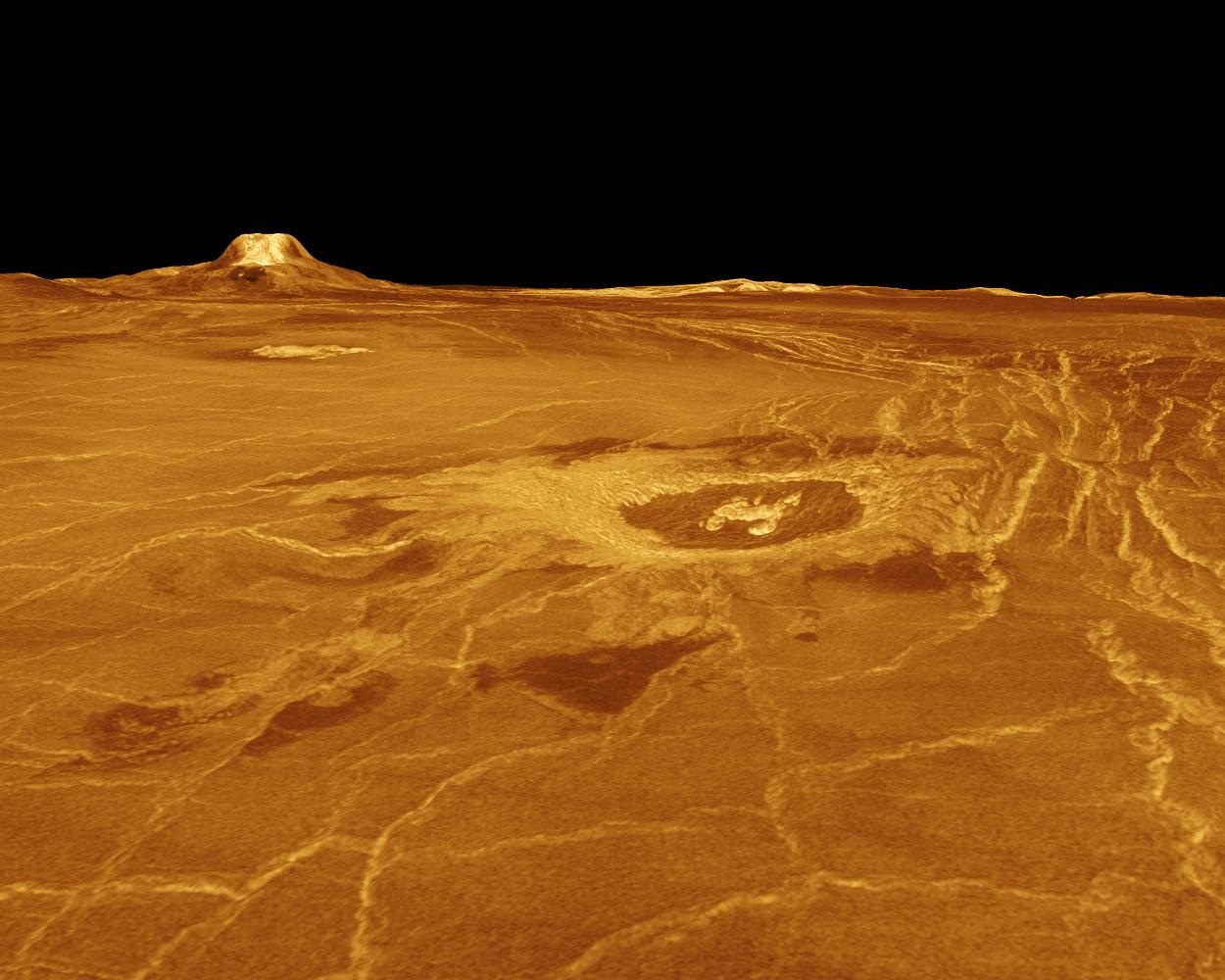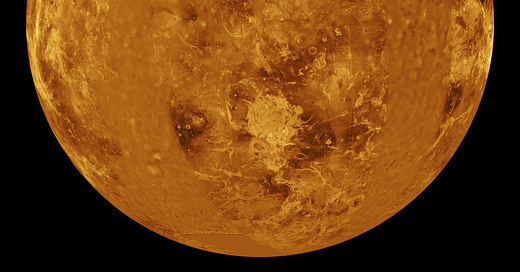
The nights on Venus are long—approximately equivalent to 58.5 Earth nights—yet if you were there and looked up into the Venus sky, none of the celestial bodies would be visible. All the stars, even the Sun are hidden behind a thick veil of clouds that cover the planet entirely. These clouds aren't the fluffy ones we know—they are a concentrated solution of sulfuric acid, hanging above a surface where the pressure is 92 times that of Earth's atmosphere, the equivalent of the pressure found one kilometre below the surface of the oceans. Venus turns out to be a very nasty place.
Venus’s atmosphere is composed of 96 percent carbon dioxide (CO2), with traces of nitrogen, water vapour, argon, carbon monoxide, and other gases. The surface temperature on Venus is soaring around 464°C (867°F). It resembles an industrial furnace used in steelmaking production.
Sunlight penetrates Venus’s massive and thick atmosphere, however, as it travels through the clouds, it is scattered and absorbed by the atmospheric particles and gases, which drastically reduces the amount of light that reaches the surface. Venus's clouds play a crucial role in reflecting sunlight back into space, giving the planet its high albedo (reflectivity). Venus reflects about 70% of the sunlight that hits it, meaning that only about 30% penetrates the atmosphere.
However, Venus’s thick atmosphere also traps heat effectively, preventing it from escaping to space. This trapped energy creates a positive feedback loop that further heats the lower atmosphere and surface of the planet, leading to an intense greenhouse effect.
The Divine Lady of the Red Heavens.
Venus has fascinated humanity for millennia. The Babylonians called it the Divine Lady of the Red Heavens, a reference to the hue of the sky when Venus becomes visible in the morning and near the evening and to its cultural importance. In Babylonian mythology, Venus was associated with the goddess Inanna (or Ishtar), one of the most important deities in the Babylonian pantheon. Inanna was the goddess of love, beauty, sex, fertility, and war, reflecting the dual nature of Venus's appearances and the powerful impact the planet had on the people.
In the early 20th century, some envisioned Venus as a lush, steamy jungle world bustling with life. Stories and novels, such as Edgar Rice Burroughs's "Carson of Venus" series, fuelled the idea of a hot, wet planet full of exotic plant and animal life. This vision captivated the public and even influenced scientific thinking at the time. But when we finally sent probes to investigate the planet, the images revealed a world vastly different from the imagined paradise.
The Venera Mission

The Soviet Union launched its first mission to Venus on February 12, 1961, with the Venera 1 probe. Unfortunately, this first mission encountered problems, resulting in losing communication with the probe only a few days after launch. It initiated, however, a series of missions that collectively changed our understanding of the planet.
On October 22, 1975, Venera 9 made history as the first spacecraft to successfully land on Venus and transmit images from its surface, followed soon after by Venera 10 on October 25. The images revealed a barren, scorching landscape, which forever changed our view of our celestial neighbour. In the 1980s, Venera 13 and 14 sent back higher quality, colour panoramic images of the Venusian landscape. To this day, four decades later, the photos from Venera 13 and 14 provide the only colour glimpse of Venus's surface.
Following the Venera missions, several expeditions, such as NASA's Mariner and Pioneer Venus missions, were conducted. These missions analysed the planet's atmospheric composition and structure, along with cloud particles and surface conditions. In 1989, NASA's Magellan Mission generated high-resolution maps that revealed detailed features of Venus's surface, including volcanoes, rift valleys, and impact craters.
A runaway greenhouse effect
But Venus wasn't always like this. Computer models simulating the early climate of Venus, suggest that the planet may have had a climate with liquid water on its surface for approximately two billion years. How did it turn into the hellscape we see today?
The answer lies in a runaway greenhouse effect. Intense solar radiation caused water to evaporate, adding more water vapour to the atmosphere. Water vapour is a potent greenhouse gas. This led to positive feedback of warming, which became self-sustaining as higher temperatures caused more water vapour to evaporate, trapping even more heat. A feedback loop that heated the planet beyond the point of no return.
It's possible that Venus once had oceans, but the runaway greenhouse effect and the loss of water to space transformed it into the dry, inhospitable planet we know today. As the atmosphere became saturated with water vapour, the upper layers were exposed to intense ultraviolet (UV) radiation from the Sun. This UV radiation had enough energy to break apart water molecules (H2O) into hydrogen (H2) and oxygen (O2). Hydrogen, the lightest atom, moves fast and therefore can escape the planet’s gravity before it recombines with other atoms or molecules. Over time, Venus lost large amounts of hydrogen and, with it, all the water that had once existed on the planet.
Sadly, Venus will not become our second home in the solar system. But because of Venus’ similarity to Earth in terms of size and surface gravity, scientists would like very much to know what strange course of events twisted the evolution of this planet, only 42 million kilometres from Earth, onto such a divergent path. It’s a sobering thought to realise that Earth might not be immune from Venus-type environmental catastrophe.

Earth's Future: A Runaway Greenhouse?
Like Venus, Earth experiences a greenhouse effect due to the presence of CO2 and water vapour. Without this effect, Earth's average temperature would be below water's freezing point. The greenhouse effect ensures our oceans remain liquid, making life viable. Hence, a moderate greenhouse effect is beneficial. Earth is often referred to as the 'Goldilocks' planet because its conditions are just right—not too hot, not too cold—supporting life. The natural greenhouse effect has historically maintained Earth's average temperature at 15°C (59°F). However, similar to Venus, Earth experiences positive feedback mechanisms. For example, melting ice reduces the Earth’s albedo (reflectivity), causing more solar absorption and further warming. Thawing permafrost releases methane, a potent greenhouse gas, intensifying the effect.
So, will Earth have a runaway greenhouse?
Yes, but not anytime soon. In the long run, over the next one to two billion years, the fate of Earth's climate is closely tied to the lifecycle of the Sun. As the sun’s luminosity gradually increases, more solar radiation will reach the Earth, leading to more intense heating of the planet’s surface. During that period, the Earth might lose its oceans and experience a Venus-like runaway greenhouse effect. Currently, however, we are not on the path to Venus-like conditions.
Unlike Venus, Earth has natural CO2 sinks, such as subductive plate tectonics and the carbonate-silicate cycle, that help in maintaining lower atmospheric CO2 concentrations, thereby mitigating greenhouse effects and maintaining a stable climate conducive to life.
But not being near the critical threshold for a runaway greenhouse effect does not mean that we can continue to ignore the climate threat posed by burning fossil fuels. If we continue to pump CO2 into the atmosphere unchecked, we risk pushing Earth's climate system beyond a critical threshold, leading to irreversible and potentially catastrophic changes such as the disintegration of large portions of the Antarctic and Greenland ice sheets. This would cause a significant rise in sea levels, potentially reaching several meters, threatening many coastal cities.

The increase in greenhouse gases has already led to a rise in global temperatures. From July 2023 to June 2024, Earth's average temperature has been unusually high, breaking records each month. Data from the Copernicus Climate Change Service indicates that the global average temperature was about 1.64°C above the pre-industrial average, reaching 16.66°C during this period.
We cannot rule out a world of 4oC temperature rise by 2100. (Sherwood & et al, 2014) Even if emissions from human activities level off this century, warming will see more permafrost melt, which will push more methane and CO2 into the air, putting upward pressure on temperatures. In summary, while Earth may not face a runaway greenhouse effect imminently, continued high emissions could lead to catastrophic changes, highlighting the importance of addressing climate change now.
Sources:
Chaffin, M. S., & et al. (2024, May 24). Venus water loss is dominated by HCO+ dissociative recombination. Nature(629), 307-310. Retrieved from https://www.nature.com/articles/s41586-024-07261-y
Copernicus: June 2024 marks 12th month of global temperature reaching 1.5°C above pre-industrial. (2024, July 4). Retrieved from Climate Copernicus : https://climate.copernicus.eu/copernicus-june-2024-marks-12th-month-global-temperature-reaching-15degc-above-pre-industrial
Harvey, B. (2007). Russian Planetary Exploration: History, Development and Prospects. Springer-Praxis,.
Sagan, C. (2014). Cosmos. London: Abacus.
Sherwood, S. C., & et al. (2014, January). Spread in model climate sensitivity traced to atmospheric convective mixing. Nature(505), 37-42. doi:https://www.nature.com/articles/nature12829
Suarez, C. A., Edmonds, M., & Adrian, P. J. (2019, October 1). Earth Catastrophes and their Impact on the Carbon Cycle. Elements, 15(5), 301-306. doi:https://doi.org/10.2138/gselements.15.5.301
Way, M. J., & et.al. (2016, August 11). Was Venus the first habitable world of our solar system? Geophysical Research Letters. doi:https://doi.org/10.1002/2016GL069790




